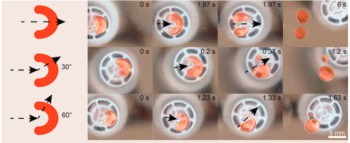
If you roll an elastic band down a slope, you might be amazed at the range of shapes it takes as it gathers speed. While this may sound like a pointless pastime, three students in the US have devised a clever experiment that allows them to explain the complicated physics behind why the shape changes in an unexpected way.
The project was inspired by Christophe Clanet while he was a visiting lecturer at the Massachusetts Institute of Technology. The work has earned Clanet – who is normally at Ecole Polytechnique in Paris – and his former students a publication in the prestigious journal Physical Review Letters.
Clanet asked his students to come up with variations on Galileo’s 17th century study of how a sphere rolls down an inclined plane. One group hit upon the idea of rolling flexible bands, which they made from vinyl polysiloxane. The bands were about 5 cm in diameter and Clanet describes the material as being similar to rubber but softer.
Tumbling bands
Instead of using an inclined plane, the team rolled the bands at a constant speed by placing them inside a hollow drum that spins like a tumble dryer. Each rotating band was photographed from the side to determine its shape, which changed dramatically as the speed of rotation was increased. The team repeated the experiment with a number of rings with differing stiffness.
When stationary or rotating at low speeds, the bands tend to be oval shaped with a slight sag in the middle cause by gravity. As the speed increases the sag becomes more pronounced creating two distinct lobes. At even higher speeds, the sag drops right down to touch the lower portion of the band (see figure).
Energy trade off
Clanet told physicsworld.com that the change in shape is caused by a trade-off involving the gravitational energy, energy of curvature, and rotational energy of the ribbon. Gravity tends to squash the band flat, but this increases the energy of curvature, which is at a minimum when the band is a circle.
One might expect a spinning band to become more circular because of the centripetal force. However, Clanet and team have found that when the effect of the centripetal force is considered at all points along the band, the net effect is a downwards force in the middle of the band that increases the sag.
Armed with this information, the team was able to successfully calculate the shapes of a number of different bands spinning at different speeds.
Reaching equilibrium
While Clanet says that the main goal of the study was to inspire his students, the research has captured the imagination of at least one group of professional physicists who are busy trying to work out how long it takes a rotating band to go from a circular shape to its equilibrium peanut shape.
He adds that the transition from oval to peanut shape is also seen in rolling water droplets and may also explain why blobs of lava sometimes solidify in lobed shapes.
The work is described in Phys. Rev. Lett. 105 044301.



